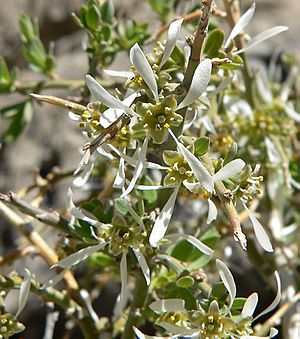Greasebush facts for kids
Quick facts for kids Greasebush |
|
|---|---|
 |
|
| Scientific classification | |
| Genus: |
Glossopetalon
|
| Species: |
spinescens
|
| Synonyms | |
|
|
Spiny greasebush (also called spiny greasewood or Nevada greasewood) is a type of flowering shrub. Its scientific name is Glossopetalon spinescens. This plant belongs to the Crossosomataceae family. You can find it growing naturally in the western United States and northern Mexico. It often grows in mountains, especially where there is limestone rock.
What Does Spiny Greasebush Look Like?
This shrub grows into a thick, upright bush. It has many thin, branching stems. These stems can be thorny. The plant can grow up to about 2 metres (6.6 ft) tall. Its green, oval-shaped leaves are quite small, less than two centimeters long.
Small white flowers grow where the leaves meet the stems. After the flowers, the plant produces a small fruit. This fruit is called a follicle. It can be a single or double pod, only a few millimeters wide.
Different Types of Spiny Greasebush
Scientists recognize two main types, or varieties, of this plant:
- var. spinescens
This type is found in southeastern Arizona, New Mexico, Texas, and parts of Mexico (Chihuahua and Coahuila). Its leaves fall off early in the season. These leaves either have no stipules (tiny leaf-like parts at the base of the leaf stem) or very small ones, less than 0.1 millimeters long.
- var. aridum
This type grows from northwestern and central Arizona all the way to California and Washington state. Unlike the other variety, its leaves stay green all year round (they are evergreen). These leaves have stipules that can be up to 0.9 millimeters long.
Images for kids
-
Glossopetalon spinescens in the White Mountains, Nevada, 1715m (5620ft) elevation in early May. The flowers are pollinated and beginning to fruit, but not all the petals have been shed. Dehiscent, persistent follicles can be seen from the previous year. The leaves have largely been shed. The tips of the stems are beginning to die off; their sharp, tapered, hardened ends function as spines.


